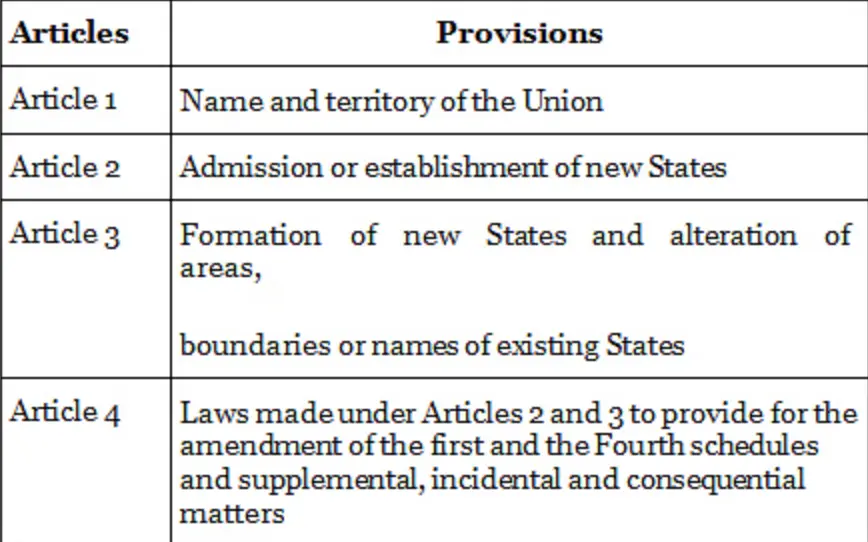- Introduction
- Understanding the Union and Its Territory (Articles 1-4)
- Historical Context: Formation and Reorganization of States
- Subsequent State Formations
- Key Case Laws
- Conclusion
Introduction
The Constitution of India is the supreme law of the land, laying down the framework that defines the political principles, structures, procedures, powers, and duties of government institutions. It also outlines the fundamental rights, directive principles, and duties of citizens.

The Constitution, originally adopted on November 26, 1949, with 395 articles in 22 parts and 8 schedules, has since grown to 448 articles in 25 parts and 12 schedules. The first part of the Constitution, titled “Union and Its Territory,” spans Articles 1 to 4 and provides a detailed account of the Union of India and its territorial boundaries.
Understanding the Union and Its Territory (Articles 1-4)
Article 1: The Union of India
Article 1 declares India, that is, Bharat, as a “Union of States.” This terminology was deliberately chosen by Dr. B.R. Ambedkar and the Constituent Assembly to emphasize the indestructible nature of India’s union.
Unlike other federations where states have the right to secede, India’s states are integral parts of the union, with no right to secede.
The term “Union of States” indicates that while states exist for administrative convenience. They do not have independent status outside the union.
Distinguishing Between “Union of India” and “Territory of India”
Union of India
This includes only the states that are part of the federal structure and share power with the central government.
Territory of India
This broader term encompasses the states, union territories, and any other territories that may be acquired by India. The First Schedule of the Constitution lists all the states and territories.
Article 2: Admission or Establishment of New States
Article 2 grants Parliament the power to admit new states into the Union or to establish new states on terms and conditions it deems fit. This provision has been used to integrate various territories, such as the French settlements of Pondicherry, into the Union of India.
Article 3: Formation of New States and Alteration of Areas, Boundaries, or Names of Existing States
Article 3 empowers Parliament to create new states, alter state boundaries, or change the names of states. The process involves the following steps:
Introduction of a Bill: A bill proposing such changes must be introduced in either House of Parliament on the recommendation of the President.
State Legislature Opinion: If the bill affects state boundaries or names, the President must refer it to the state legislature for its opinion, though Parliament is not bound to accept the state’s views.
Union Territories: In the case of Union Territories, no state legislature’s opinion is required.
This article underscores the centralized nature of India’s federal system, where the Union government has significant control over state boundaries and names.
Article 4: Provisions Related to Articles 2 and 3
Article 4 provides that any law made under Article 2 or 3 shall also amend the First Schedule (names of the states) and the Fourth Schedule (allocation of seats in the Rajya Sabha). Importantly, such amendments do not require a constitutional amendment under Article 368, emphasizing Parliament’s authority in reorganizing states.
Historical Context: Formation and Reorganization of States
The reorganization of Indian states has been a continuous process since independence, driven by linguistic, cultural, and administrative needs.
Early Commissions and Committees
Dhar Commission (1948): Recommended reorganization of states based on administrative convenience rather than linguistic lines.
JVP Committee (1949): Reaffirmed the Dhar Commission’s recommendations, delaying the formation of linguistic states.
State Reorganization Act, 1956
This Act, along with the Seventh Constitutional Amendment, reorganized states primarily based on linguistic lines, abolishing the previous classification of states into Parts A, B, C, and D. It created 14 states and 6 union territories, laying the foundation for the current state structure.
Subsequent State Formations
Several new states have been created post-1956, such as:
- Gujarat and Maharashtra (1960)
- Nagaland (1962)
- Haryana (1966)
- Himachal Pradesh (1970)
- Sikkim (1975)
- Telangana (2014)
- Ladakh (2019)
Also Read: Origin of the Fundamental Rights
Key Case Laws
Berubari Union Case (1960): The Supreme Court ruled that ceding Indian territory to a foreign country requires a constitutional amendment.
Mullaperiyar Environment Protection Forum v. Union of India (2006): Reaffirmed the supremacy of Parliament in legislative matters concerning state boundaries and territories.
Conclusion
The Constitution of India, through its provisions on the Union and its Territory, ensures the unity and integrity of the nation. The power to reorganize states lies firmly with Parliament, reflecting the centralized nature of the Indian federation. This structure has allowed India to adapt to changing political and social dynamics while maintaining its territorial integrity.
FAQs
What does Article 1 of the Indian Constitution state?
Article 1 declares India as a “Union of States,” emphasizing the indestructible nature of the Indian Federation where no state has the right to secede.
How can new states be created in India?
Under Article 2 and Article 3, Parliament can admit new states or alter the boundaries and names of existing states through legislation.
What is the significance of the State Reorganization Act, of 1956?
The Act reorganized Indian states primarily based on linguistic lines, establishing the modern state structure and abolishing the earlier classification of states.
Also Read: Key Features of the Indian Constitution
Reference: clearias.com